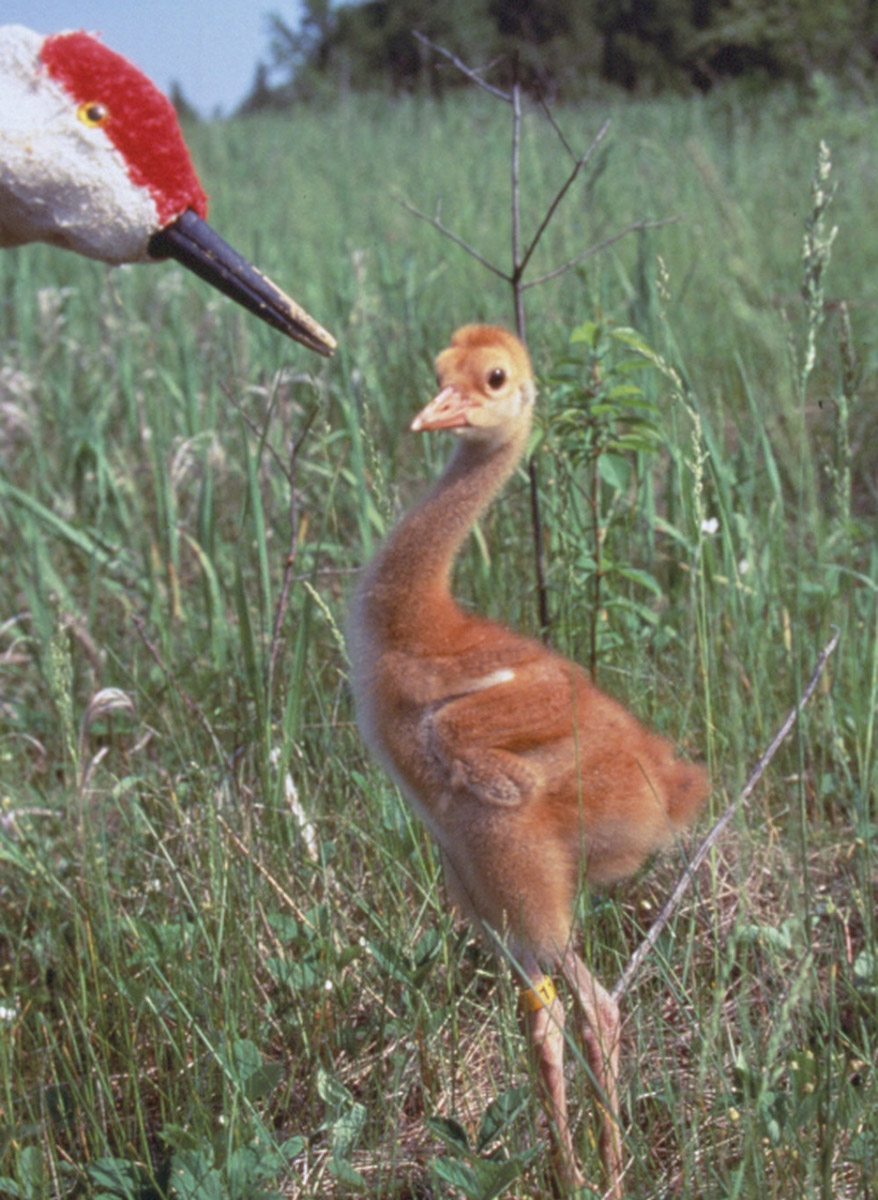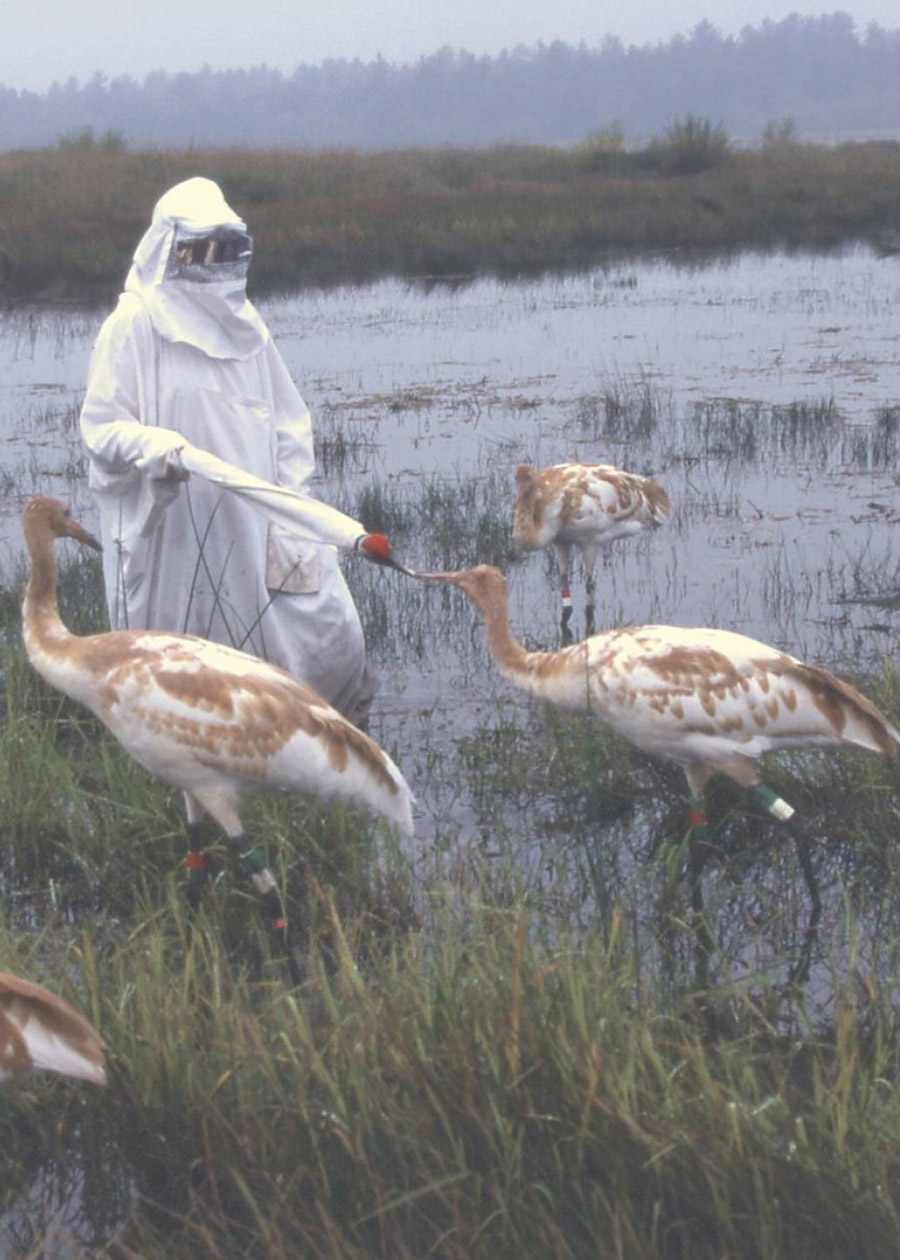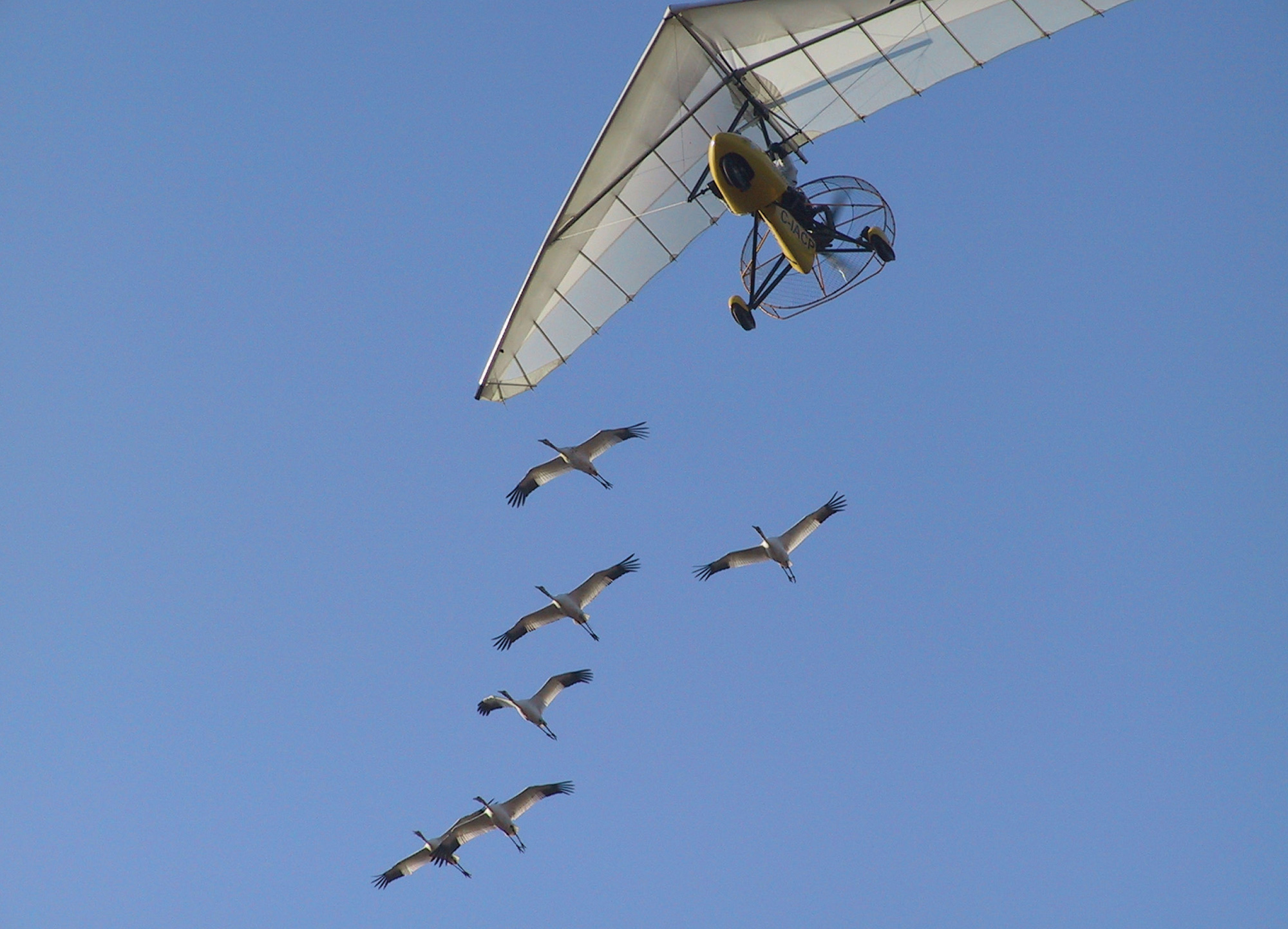For the Birds: An Interview with Bill Lishman
Father Goose and his whooping cranes
Sara Harris and Bill Lishman
For the last 18 years, a small group of scientists, conservationists, and extreme fliers around the world have dedicated their lives to coaxing endangered birds back from the brink of extinction by guiding their migration with hang-gliders and small planes called ultralights. In 1986, Bill Lishman began to teach a flock of geese to follow him on a migration in an ultralight aircraft in Ontario, Canada. A pioneer known as “Father Goose,” Lishman was the first person to fly with birds. After three years of flying with geese, Lisman began to work with the highly endangered whooping crane. In 1994, he co-founded the not-for-profit group Operation Migration, which in 2001 made the world’s longest human-assisted migration with a flock of whooping cranes that had been raised in captivity. Sara Harris spoke to Lishman by phone.
Sara Harris: Why did you start flying with geese?
Bill Lishman: The geese are not an endangered species. I’d imprinted a flock of geese to fly with my aircraft in 1988, after three years of trying. Since I was a kid I had wanted to fly like a bird. I think that’s just a common desire for a lot of kids. I just happened to be at the right time and flying ultralight aircraft, and I realized that this was the first time in history that we had aircraft that could sustain flight with birds at the right speed. All aircraft prior to that had flown too fast or were not suited to fly with birds.
When were the ultralights invented?
They evolved out of hang-gliding in the 1970s. I went to Oshkosh, Wisconsin, to the big annual air show there in 1976 and I saw John Moody fly this little biplane aircraft, take off on foot, and fly into the air with a little chainsaw engine in the back going like crazy. And that was really the birth of ultralight flying. I duplicated what he did here in Canada two years later. It sounded like a chainsaw gone berserk and it looked more like something the Wright Brothers would have flown. That was the state-of-the-art at the time.
If it had an engine that loud, how did you get birds to fly alongside it without scaring them?
I had a mentor who had done a lot of research with birds and had trained a lot of animals for movies. The right term is “fit into the pattern of the birds.” That’s what I did with the original geese. I went through one year where I trained them to fly with my motorcycle.
You trained them to fly with a motorcycle?
What happens is when a bird hatches, the thing that it hatches under becomes its parent or its mother. So if you’re there when it hatches, it automatically attaches to you because it thinks, “Oh, that must be mother.” So what you do is you introduce the motorcycle to them at the same time when they first hatch. You walk them outside on that first day and you start up the engine, and they’ll huddle around you, and if that’s safe, then they’re safe. What I discovered later was you can just tape-record the sound of the ultralight’s engine and you play it for them even while they are in the incubator before they hatch, so that sound is part of their milieu. It’s natural to them. When they first hatch you take them for a walk alongside the tape recorder and they hear the sound of the engine. Right from day one.
So from the motorcycle you took the next step to the ultralight?
Right, but I couldn’t convert them from the motorcycle to the aircraft. That was mistake one. I started out in 1986. I had a flock of geese that would fly with my motorcycle, but when it came to switching over to the airplane, it was impossible. The friend that was teaching me had raised birds to fly with his bicycle and with his boat, and he’s got fantastic film footage of geese flying. He’d get them imprinted on him and walk around with them everyday for about ten weeks—you see it takes about ten weeks from when they hatch until they start to fly—and when they got old enough to fly he’d put them in a big chicken crate and load them on his boat, drive out into the middle of the lake, open up the crate, let them out overboard, start up the motor, and drive back to shore. And they’d fly right alongside him. They were imprinted right on him, not the boat.
How does “imprinting” work? Do you get the birds to identify with a person or with a machine?
You have them identify with the person, or with the aircraft, or both. It’s all part of the family. You can have them imprint on the dog, if you could get a dog to take a walk with them. In nature, the bird doesn’t know what its parent should look like when it hatches. It just attaches itself to whatever is big and warm or big and noisy—whatever’s next to it. This is only true for precocial birds. Only larger waterfowl like ducks, geese, and swans imprint on their parents. They learn what to eat and how to fly from them. They learn their first migration route from them.
But with the cranes that you raise, you imprint them on people in costumes and use a puppet that looks like a crane. Why?
We don’t want the cranes to be imprinted on human beings, so we put on this crazy costume that no one else would ever wear so that they will be imprinted on the costume, and they’ll have a natural fear of humans. We call it the “crane burka.” It’s just one big white bag that covers you from head to foot with a screen that you can see through so they can’t see your hands or your eyes. Then we hold a puppet in one hand that looks like the neck of the crane with a beak, and in our pocket is an MP3 unit with a speaker that plays three or four different adult cranes calls.



What does it sound like?
It’s called a contact call. It sounds like prrrrr ... prrrrrr. Once I got to fly with geese, I could lead geese anywhere, but why would I want to do that? They’re not endangered, so to teach them a migration route would have been futile. The only reason for doing it with geese was to use them as guinea pigs. Later we wanted to see if it was workable with birds that are endangered like whooping cranes. So we moved on to sandhill cranes, which are a close cousin to whooping cranes, and we did several migrations with those cranes to work out the protocols for keeping the birds wild and to lead them on a migration in the natural patterns of bird life. We wanted to do this without impinging on their natural propensity to be wild. There was a lot of doubt that our techniques would make them imprint on humans and that they would never become wild. There was some worry that when they reached mating age they wouldn’t have the right sexual instincts, that they might want to mate with humans or something like that.
How did you avoid that?
We had to develop a technique. All we wanted them to do was follow the aircraft south once, not be imprinted on people, and not land anywhere near people. So we had to find a route that had stops that were remote from human paraphernalia, and there was no human communication between us and them. They never heard our voices; they only heard the sounds of recordings of the adult cranes. Once we had that perfected this with sandhill cranes, we could move on to whooping cranes.
So saving the whooping crane is really the focus of your work.
The whooping crane was down to about 16 birds in the 1940s. They were in one migratory flock that migrates between Texas and the Northwest Territories of Canada, about 3000 miles. It’s a long flight, and if it weren’t for an Audubon biologist by the name of Robert Porter Allan, they would probably be extinct by now. But he drew attention to their plight and got people to stop shooting them. The first settlers that came here shot thousands until 1917 when a law was put in place to protect them. Now there are just under 400 whooping cranes. There are 185 in that original wild flock, and we are working with a captive flock that needs to be reintroduced. We are introducing a whole new flock that migrates between Wisconsin and Florida to keep the populations separate as an insurance flock in case something happens to the original one. We’re going into our third year of that project. We started by flying seven birds to Florida in 2001, and five of them made it from Wisconsin. Two of them were eaten by bobcats. Those five birds made it back on their own, and now they are migratory. We raised another 17 last year, and now there are 21 birds in that flock. We’re adding another 20 this year, and the goal is to get 100 birds in that flock, and we’ll know it really works when the offspring of this flock start migrating.
Cranes cover a lot of distance. How fast can they fly, and how hard is it to find stretches of land to take off and land where there is no human presence?
They’ll cruise anywhere between 35 and 40 miles per hour. It was difficult to find the space, but the way we lead them south, we can’t fly as efficiently as they can at all. The very technique we use limits us to flying short distances. For example, in the ultralights we are so limited by the weather that even a headwind can keep us grounded. We flew 49 days last year to get these birds 1,200 miles from Wisconsin to Florida but the total time flying was about 35 hours. The cranes that we raised in 2001 flew the whole route in five days. They passed us en route. We left way before them, and they caught up and passed us in Tennessee and were in Florida by the time we got there. So we haven’t screwed up their natural way of migrating, but we’ve just shown them the route. And they don’t even follow the route we show them.
They don’t?
No. The first time we flew the whooping cranes south in 2001 was just after 9/11, so we had to divert around all these no-fly-zones and fly a dog-leg route to Florida. When they came north, they flew straight right across Indianapolis and Chicago, and when they got up to Wisconsin they were 80 miles too far east. They turned 90 degrees when they got to the right latitude and they flew right into where they’d been raised.

How did they know where to go?
There are a number of theories, but no one really knows why.
Can you explain what the thermals are that cranes use to fly?
If you look into a pot of boiling water, just as it starts to boil, you see little bubbles that start at the bottom and rise to the top. The same thing happens in the air but you can’t see it. The little bubbles of air are warmed up by the sun hitting a ploughed field or a parking lot. A bubble forms and rises up until it becomes a cloud. On a summer day you can see these little puffy clouds—that’s the top of one of those bubbles, which are called thermals. So birds will fly along until they hit one of these bubbles that are naturally rising and get in and go up in it. They have an instinctual understanding of when they have lift. They’ve been doing it for millions of years, so they’ll fly in a circle until they hit a bubble and they stay in it until they get up to several thousand feet. When they level out at the cloud base and stop rising, they just peel out of it and hold their wings out and glide. They have such a wonderful glide ratio they can go for miles without losing a great deal of altitude until they hit another thermal and then they go up again. They use solar energy to cruise across the countryside.
Do all birds fly in the same way? What about geese?
Geese are wing flappers. They don’t use thermal lift. One reason they fly in “Vs” is that the group of birds uses lesstotal energy than if one bird were to fly on its own. The lead bird creates a little wave off the wing tip, and the following birds add to that wave. The group in general saves a lot of energy by doing that. So when the lead gets tired, it drops back and one of the birds that has been cruising at the back and has had a rest will take the lead. Even the cranes will fly in a “V” when they break out of the thermals, but they don’t flap, they just glide. The cranes fly in groups of 5 or 6, and the geese will fly in formations of 60 to 100.
I grew up in Chicago, and I started to notice that the Canada geese never leave anymore. Have you noticed that?
The geese don’t migrate anymore. Back in the 1960s, the Midwest farmers started to grow so much corn, and that with what was left in the fields the geese never needed to leave. Lake Michigan doesn’t freeze and in the city no one shoots at them.
Do birds have distinct personalities, or are all the birds basically the same?
Oh no, they all have personalities. They’re all different characters. Geese recognize their own kind. They have certain instinctive habits and they don’t recognize the habits of the crane. Cranes are aloof. Geese are gregarious.
Was your relationship different with each species?
Oh yes. Working with cranes, we don’t want to get to know them very well. We try and remain as aloof as possible and remote so we don’t get attached to them. When I started working with geese, that was very fresh for me, and so I sort of got attached to them, but with the cranes we try to keep our distance.
What does it feel like to fly with birds?
It’s an absolutely wonderful experience. When you fly by yourself in this machine, it’s kind of noisy, and there’s always this fear that the engine will quit or something like that. Somehow, when you get with the birds in their own element, there’s no fear. If you’re up there alone, there’s you and the earth, but when you’re up there with the birds, it’s you and the birds, and the depth of perception is wonderful, and the perception of the planet from their perspective is instilled in your head, and you see things in a prehistoric way. You are cruising with these birds on their traditional migration across the planet in the way that they’ve been doing it for millions of years.
Thanks to Claire Mirande at the Saving Cranes Foundation and Heather Ray at Operation Migration. Photos provided courtesy of Operation Migration, Ontario, Canada.
Bill Lishman, a.k.a Father Goose, is the co-founder of the not-for-profit organization Operation Migration, which in 2001 made the world’s longest human-assisted migration with a flock of whooping cranes raised in captivity.
Sara Harris is an independent radio journalist working for The Next Big Thing, WNYC, New York, and Youth Radio, Berkeley, CA. She lives in Los Angeles.
Spotted an error? Email us at corrections at cabinetmagazine dot org.
If you’ve enjoyed the free articles that we offer on our site, please consider subscribing to our nonprofit magazine. You get twelve online issues and unlimited access to all our archives.